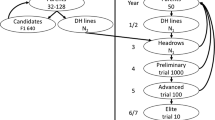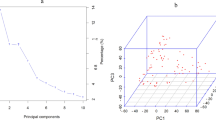Abstract
Molecular characterization of doubled haploid (DH) maize lines and estimation of parental genome contribution (PGC) may be useful for choosing pairs of DH lines for hybrid make up and new pedigree starts. Six BC1-derived DH populations created by crossing two donor with three recurrent parents were genotyped with 97,190 polymorphic markers with the objectives of: (i) understanding genetic purity, genetic distance and relationship among 417 maize DH lines; (ii) estimating PGC of the DH lines derived from different genetic backgrounds; and (iii) understanding the correlation between donor parent introgression and testcross performance for grain yield and anthesis-silking interval (ASI) under managed drought and optimum environments. The DH lines were 97 % genetically pure, with <2 % heterogeneity; only two DH lines showed heterogeneity >5 %, which is likely to be due to errors during seed multiplication or maintenance. Genetic distance between pairwise comparisons of the 417 DH lines ranged from 0.055 to 0.457; only 0.01 % showed a genetic distance <0.100, indicating large genetic differences among the DH lines. Both populations 1 and 6 showed significantly lower (p < 0.001) donor introgression than the other four populations. Donor parent contribution was significantly (p < 0.001) higher in the CML444 genetic background than CML395 and CML488. The average donor and recurrent PGC across all 417 DH lines was 31.7 and 64.3 %, respectively. Donor genome introgression was higher than expected in 82 % of the DH lines in the BC1 generation, possibly due to artificial selection during the DH process, during the development of F1 or BC1 seed, or during initial agronomic evaluation of the DH lines. Donor parent introgression up to 32 % showed significant positive correlation with grain yield under drought (r = 0.312, p < 0.001) and optimum (r = 0.142, p < 0.050) environments but negative correlation with ASI under drought (r = −0.276, p < 0.001). Additional multi-environment phenotype data under managed drought are needed to confirm the correlations reported in this study and to map the specific genomic regions associated with such correlations.



Similar content being viewed by others
References
Beissinger TM, Hirsch CN, Sekhon RS, Foerster JM, Johnson JM, Muttoni G, Vaillancourt B, Buell CR, Kaeppler SM, de Leon N (2013) Marker Density and read-depth for genotyping populations using genotyping-by-sequencing. Genetics 193:1073–1081
Bernardo R, Murigneux A, Maisonneuve JP, Johnsson C, Karaman Z (1997) RFLP-based estimates of parental contribution to F2- and BC1-derived maize inbreds. Theor Appl Genet 94:652–656
Beyene Y, Mugo S, Pillay K, Tefera T, Ajanga S, Njoka S, Karaya H, Gakunga J (2011) Testcross performance of doubled haploid maize lines derived from tropical adapted backcross populations. Maydica 56:351–358
Beyene Y, Mugo S, Semagn K, Asea G, Trevisan W, Tarekegne A, Tefera T, Gethi J, Kiula B, Gakunga J, Karaya H, Chavangi A (2013) Genetic distance among doubled haploid maize lines and their testcross performance under drought stress and non-stress conditions. Euphytica 192:379–392
Bradbury PJ, Zhang Z, Kroon DE, Casstevens TM, Ramdoss Y, Buckler ES (2007) TASSEL: software for association mapping of complex traits in diverse samples. Bioinformatics 23:2633–2635
Brenner EA, Blanco M, Gardner C, Lübberstedt T (2012) Genotypic and phenotypic characterization of isogenic doubled haploid exotic introgression lines in maize. Mol Breed 30:1001–1016
Campos H, Cooper M, Habben JE, Edmeades GO, Schussler JR (2004) Improving drought tolerance in maize: a view from industry. Field Crops Res 90:19–34
Duvick DN (2001) Biotechnology in the 1930s: the development of hybrid maize. Nat Rev Genet 2:69–74
Edmeades GO, Bolanos J, Lafitte HR, Rajaram S, Pfeiffer W, Fischer RA (1989) Traditional approaches to breeding for drought resistance in cereals. In: Proceedings of a symposium held in Cairo, Egypt, 28–30 November, pp 27–52
Elshire RJ, Glaubitz JC, Sun Q, Poland JA, Kawamoto K, Buckler ES, Mitchell SE (2011) A robust, simple genotyping-by-sequencing (GBS) approach for high diversity species. PLoS One 6:e19379
Foolad MR, Zhang LP, Lin GY (2001) Identification and validation of QTLs for salt tolerance during vegetative growth in tomato by selective genotyping. Genome 44:444–454
Frisch M, Melchinger AE (2007) Variance of the parental genome contribution to inbred lines derived from biparental crosses. Genetics 176:477–488
Hayano-Saito Y, Tsuji T, Fujii K, Saito K, Iwasaki M, Saito A (1998) Localization of the rice stripe disease resistance gene, Stv-bi, by graphical genotyping and linkage analyses with molecular markers. Theor Appl Genet 96:1044–1049
Heckenberger M, Bohn M, Ziegle JS, Joe LK, Hauser JD, Hutton M, Melchinger AE (2002) Variation of DNA fingerprints among accessions within maize inbred lines and implications for identification of essentially derived varieties. I. Genetic and technical sources of variation in SSR data. Mol Breed 10:181–191
Heckenberger M, Bohn M, Melchinger AE (2005) Identification of essentially derived varieties obtained from biparental crosses of homozygous lines: I. Simple sequence repeat data from maize inbreds. Crop Sci 45:1120–1131
Heckenberger M, Muminovic J, Voort JR, Peleman J, Bohn M, Melchinger AE (2006) Identification of essentially derived varieties obtained from biparental crosses of homozygous lines. III. AFLP data from maize inbreds and comparison with SSR data. Mol Breed 17:111–125
Hu Z, Ehlers J, Roberts P, Close T, Lucas M, Wanamaker S, Xu S (2012) ParentChecker: a computer program for automated inference of missing parental genotype calls and linkage phase correction. BMC Genet 13:9
McCouch SR, Chen X, Panaud O, Temnykh S, Xu Y, Cho Y, Huang N, Ishii T, Blair M (1997) Microsatellite marker development, mapping and applications in rice genetics and breeding. Plant Mol Biol 35:89–99
Melchinger AE, Dhillon BS, Mi X (2010) Variation of the parental genome contribution in segregating populations derived from biparental crosses and its relationship with heterosis of their Design III progenies. Theor Appl Genet 120:311–319
Murigneux A, Barloy D, Leroy P, Beckert M (1993) Molecular and morphological evaluation of doubled haploid lines in maize. 1. Homogeneity within DH lines. Theor Appl Genet 86:837–842
Ndjiondjop MN, Semagn K, Sie M, Cissoko M, Fatondji B, Jones M (2008) Molecular profiling of interspecific lowland rice populations derived from IR64 (Oryza sativa) and Tog5681 (Oryza glaberrima). Afr J Biotechnol 7:4219–4229
Prigge V, Maurer HP, Mackill DJ, Melchinger AE, Frisch M (2008) Comparison of the observed with the simulated distributions of the parental genome contribution in two marker-assisted backcross programs in rice. Theor Appl Genet 116:739–744
Ribaut JM, Ragot M (2007) Marker-assisted selection to improve drought adaptation in maize: the backcross approach, perspectives, limitations, and alternatives. J Exp Bot 58:351–360
Romay M, Millard M, Glaubitz J, Peiffer J, Swarts K, Casstevens T, Elshire R, Acharya C, Mitchell S, Flint-Garcia S, McMullen M, Holland J, Buckler E, Gardner C (2013) Comprehensive genotyping of the USA national maize inbred seed bank. Genome Biol 14:R55
Rv Berloo, Aalbers H, Werkman A, Niks RE (2001) Resistance QTL confirmed through development of QTL-NILs for barley leaf rust resistance. Mol Breed 8:187–195
Sambatti JBM, Caylor KK (2007) When is breeding for drought tolerance optimal if drought is random? New Phytol 175:70–80
Semagn K (2014) Leaf tissue sampling and DNA extraction protocols. In: Besse P (ed) Molecular plant taxonomy: methods and protocols. Human Press, New York, pp 53–67
Semagn K, Ndjiondjop MN, Lorieux M, Cissoko M, Jones M, McCouch S (2007) Molecular profiling of an interspecific rice population derived from a cross between WAB 56-104 (Oryza sativa) and CG 14 (Oryza glaberrima). Afr J Biotechnol 6:2014–2022
Semagn K, Beyene Y, Makumbi D, Mugo S, Prasanna BM, Magorokosho C, Atlin G (2012) Quality control genotyping for assessment of genetic identity and purity in diverse tropical maize inbred lines. Theor Appl Genet 125:1487–1501
Semagn K, Beyene Y, Warburton M, Tarekegne A, Mugo S, Meisel B, Sehabiague P, Prasanna B (2013) Meta-analyses of QTL for grain yield and anthesis silking interval in 18 maize populations evaluated under water-stressed and well-watered environments. BMC Genom 14:313
Semagn K, Babu R, Hearne S, Olsen M (2014) Single nucleotide polymorphism genotyping using Kompetitive Allele Specific PCR (KASP): overview of the technology and its application in crop improvement. Mol Breed 33:1–14
Severson DW, Kassner VA (1995) Analysis of mosquito genome structure using graphical genotyping. Insect Mol Biol 4:279–286
Shiferaw B, Prasanna BM, Hellin J, Bänziger M (2011) Crops that feed the world 6. Past successes and future challenges to the role played by maize in global food security. Food Secur 3:307–327
van Berloo R (1999) Computer note. GGT: software for the display of graphical genotypes. J Hered 90:328–329
Wilde K, Burger H, Prigge V, Presterl T, Schmidt W, Ouzunova M, Geiger HH (2010) Testcross performance of doubled-haploid lines developed from European flint maize landraces. Plant Breed 129:181–185
Young ND, Tanksley SD (1989) Restriction fragment length polymorphism maps and the concept of graphical genotypes. Theor Appl Genet 77:95–101
Acknowledgments
DH lines used in this study and their phenotypic data were generated as part of the WEMA project, funded by the Bill & Melinda Gates Foundation. GBS data were generated as part of the Basic Research to Enabling Agricultural Development (BREAD) project, funded by the US National Science Foundation. We are grateful to CIMMYT Field Technicians at the different stations in Kenya for the phenotypic evaluation, and Monsanto Company for developing the DH populations.
Author information
Authors and Affiliations
Corresponding author
Electronic supplementary material
Below is the link to the electronic supplementary material.
10681_2014_1238_MOESM3_ESM.xlsx
Supplementary material 3: Parental genome contribution and testcross performance under managed drought and optimum environments. (XLSX 55 kb)
Rights and permissions
About this article
Cite this article
Ogugo, V., Semagn, K., Beyene, Y. et al. Parental genome contribution in maize DH lines derived from six backcross populations using genotyping by sequencing. Euphytica 202, 129–139 (2015). https://doi.org/10.1007/s10681-014-1238-6
Received:
Accepted:
Published:
Issue Date:
DOI: https://doi.org/10.1007/s10681-014-1238-6




